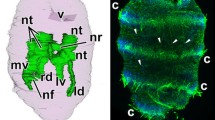Summary
The statocysts of Leptomedusae are formed as a depression in the velum. They are lined on the inside towards the distal part of the velum by thin epithelium and towards the proximal part by ciliated sensory cells. Lithocytes are present in the centre. The concretion contains calcium sulphate and in some cases, calcium phosphate is also present in addition to some membranous material.
The statocysts of Narcomedusae arise from the exumbrellar nerve ring as free sensory clubs. They have a proximal basal cushion of sensory cells from the centre of which arises a sensory club (Aegina) or a sensory papilla carrying a sensory club (Solmissus). The sensory club has an axial strand of endodermal cells covered by ciliated sensory cells. Some of the endodermal cells have a concretion. While the statocysts of Leptomedusae are totally ectodermal, those of Narcomedusae are ecto-endodermal in origin.
The sensory cilia of Leptomedusae, especially those present on the sensory cells adjacent to the lithocyte, run close and parallel to the lithocyte membrane. In Narcomedusae the sensory cilia of the basal cushion and sensory papilla are tall and strong. Ciliary rootlets are missing in the sensory cilia of Leptomedusae and in the sensory club of Narcomedusae but they are strongly developed in the cilia of basal cushion and sensory papilla. The cilia have 9+2 filament content. A ring of stereocilia surrounds the kinocilium of the sensory club cells. Mechanism of statocyst function is discussed.
Similar content being viewed by others
References
Bouillon, J.: Etude monographique du genre Limocnida (Limnomedusae). Ann. Soc. Zool. Belg. 87, 11, 253–500 (1956)
Bozler, E.: Sinnes-und nervenphysiologische Untersuchungen an Scyphomedusen. Z. vergl. Physiol. 4, 37–80 (1926)
Dorey, A. E.: The organisation and replacement of epidermis in acoellus turbellarians. Quart. J. micr. Sci. 106, 147–172 (1965)
Fränkel, G.: Der statische Sinn der Medusen. Z. vergl. Physiol. 2, 658–690 (1925)
Goldman, D. E.: The transducer action of mechanoreceptor membranes. Cold Spr. Harb. Symp. quant. Biol. 30, 59–68 (1965)
Hawkins, J. E.: Cytoarchitectural basis of the cochlear transducer. Cold Spr. Harb. Symp. quant. Biol. 30, 147–157 (1965)
Hertwig, O., Hertwig, R.: Das Nervensystem und die Sinnesorgane der Medusen. Leipzig 1878
Hillman, D. E., Lewis, E. R.: Morphological basis for a mechanical transduction in the frog. Science 174, 416–418 (1971)
Horridge, G. A.: The nerves and muscles of medusae IV. Inhibition in Aequorea forskalia. J. exp. Biol. 32, 642–648 (1955)
Horridge, G. A.: Statocysts of medusae and evolution of stereocilia. Tissue and Cell 1, 341–353 (1969)
Humason, G. L.: Animal tissue technique, p. 261. San Francisco: Freeman & Co. 1966
Lillie, R. D.: Histopathologic technique and practical histochemistry. Toronto: McGraw-Hill Co. 1965
Linko, A.: Bau der Augen bei den Hydromedusen. Acad. Imp. Sci. St. Petersbourg. Mem. Ser.8, 10, 1–22 (1900)
Luft, J. H.: Improvement in epoxy resin embedding methods. J. biophys. biochem. Cytol. 9, 409–414 (1961)
Richardson, K. C., Jarett, L., Finke, E. H.: Embedding in epoxy resin for ultrathin sectioning in electron microscopy. Stain Technol. 35, 313–322 (1960)
Russell, F. S.: The medusa of the British Isles. London: Cambridge University Press 1953
Spangenberg, D. B.: Statolith differentiation in Aurelia aurita. J. exp. Zool. 169, 487–499 (1968)
Spangenberg, D. B., Beck, C. W.: Calcium sulphate dihydrate in Aurelia. Trans. Amer. micr. Soc. 87, 329–335 (1968)
Thürm, U.: An insect mechanoreceptor. I. Fine structure and adequate stimulus. Cold Spr. Harb. Symp. quant. Biol. 30, 75–82 (1965)
Venable, H. J., Coggeshall, R. A.: A simplified lead citrate stain for use in electron microscopy. J. Cell Biol. 25, 407–408 (1965)
Webster, D. B.: Ear structure and function in modern mammals. Amer. Zool. 6, 451–466 (1966)
Wenger, B. S.: Construction and use of the vibrating needle for embryonic operations. Bioscience 18, 226–228 (1967)
Young, J. Z.: The statocysts of Octopus vulgaris. Proc. roy. Soc. B 152, 3–29 (1960)
Author information
Authors and Affiliations
Additional information
I am indebted to Professor G. O. Mackie for his valuable criticism and Dr. R. L. Fernald for the use of facilities of the University of Washington, Friday Harbor Laboratory. I am grateful to Mr. H. F. Dietrich for technical help.
Rights and permissions
About this article
Cite this article
Singla, C.L. Statocysts of hydromedusae. Cell Tissue Res. 158, 391–407 (1975). https://doi.org/10.1007/BF00223835
Received:
Revised:
Issue Date:
DOI: https://doi.org/10.1007/BF00223835




